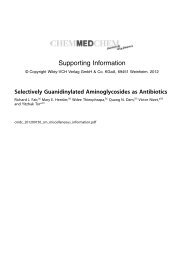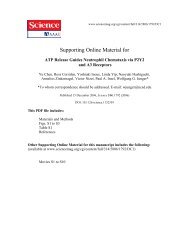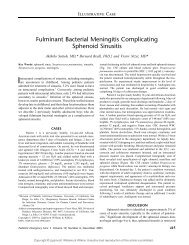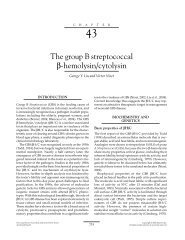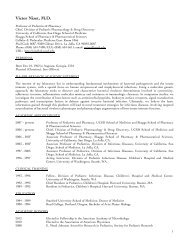BACTERIAL SEPSIS AND MENINGITIS - Nizet Laboratory at UCSD
BACTERIAL SEPSIS AND MENINGITIS - Nizet Laboratory at UCSD
BACTERIAL SEPSIS AND MENINGITIS - Nizet Laboratory at UCSD
Create successful ePaper yourself
Turn your PDF publications into a flip-book with our unique Google optimized e-Paper software.
altern<strong>at</strong>ive p<strong>at</strong>hway components; diminished polymorphonuclear<br />
leukocyte production, mobiliz<strong>at</strong>ion, and function;<br />
diminished T-lymphocyte cytokine production to many<br />
antigens; and reduced levels of lactoferrin and transferrin<br />
[686]. Recognition of these factors has resulted in <strong>at</strong>tempts<br />
<strong>at</strong> therapeutic intervention aimed specifically <strong>at</strong> each<br />
component of the deficient immune response [690].<br />
Infants are protected from infection by passively transferred<br />
m<strong>at</strong>ernal IgG. To enhance the infant’s ability to<br />
ward off severe infections, immuniz<strong>at</strong>ion of pregnant<br />
women and women in their childbearing years has been<br />
selectively adopted [688,691–693]. Programs in countries<br />
with limited resources to immunize pregnant women with<br />
tetanus toxoid have markedly decreased the incidence of<br />
neon<strong>at</strong>al tetanus. Investig<strong>at</strong>ional programs for immuniz<strong>at</strong>ion<br />
of pregnant women with polysaccharide pneumococcal,<br />
H. influenzae type b, and group B streptococcal<br />
vaccines aim to provide infants with protection in the first<br />
months of life. Studies of safety and immunogenicity of<br />
polysaccharide conjug<strong>at</strong>e vaccines for GBS show promise<br />
of a reduction in incidence of l<strong>at</strong>e-onset and early-onset<br />
disease in newborns [693]. Use of vaccines in pregnant<br />
women is discussed in Chapter 1.<br />
Several clinical trials have explored the use of IVIG to<br />
correct the antibody deficiency of neon<strong>at</strong>es, particularly<br />
very preterm newborns, and reduce the incidence of sepsis.<br />
In 1994, the NICHD Neon<strong>at</strong>al Research Network<br />
reported a randomized clinical trial of 2416 subjects to<br />
determine the effects of prophylactic IVIG on the risk<br />
of sepsis in prem<strong>at</strong>ure neon<strong>at</strong>es [694]. No reduction in<br />
mortality, morbidity, or incidence of nosocomial infections<br />
was achieved by IVIG administr<strong>at</strong>ion. The use of<br />
hyperimmune IVIG prepar<strong>at</strong>ions and human monoclonal<br />
antibodies to prevent specific infections (e.g., CoNS,<br />
S. aureus) in high-risk neon<strong>at</strong>es is also an area of active<br />
explor<strong>at</strong>ion; however, although these products seem to<br />
be safe and well toler<strong>at</strong>ed, no reduction in staphylococcal<br />
infection was documented in two more recent large, randomized<br />
multicenter studies [695,696]. A system<strong>at</strong>ic<br />
meta-analysis of 19 published studies through 2003<br />
including approxim<strong>at</strong>ely 5000 infants calcul<strong>at</strong>ed th<strong>at</strong><br />
IVIG prophylaxis provided a 3% to 4% reduction in nosocomial<br />
infections, but did not reduce mortality or other<br />
important clinical outcomes (e.g., necrotizing enterocolitis,<br />
length of hospital stay) [697]. The costs of IVIG and<br />
the value assigned to these clinical outcomes are expected<br />
to dict<strong>at</strong>e use; basic scientists and clinicians need to<br />
explore new avenues for prophylaxis against bacterial<br />
infection in this special p<strong>at</strong>ient popul<strong>at</strong>ion [697].<br />
An older study by Sidiropoulos and coworkers [698]<br />
explored the potential benefit of low-dose (12 g in 12<br />
hours) or high-dose (24 g daily for 5 days) IVIG given<br />
to pregnant women <strong>at</strong> risk for preterm delivery because<br />
of chorioamnionitis. Cord blood IgG levels were doubled<br />
in infants older than 32 weeks’ gest<strong>at</strong>ional age whose<br />
mothers received the higher dosage schedule, but were<br />
unaffected in infants born earlier, suggesting little or no<br />
placental transfer of IVIG before the 32nd week of gest<strong>at</strong>ion.<br />
Among the infants delivered after 32 weeks, 6 (37%)<br />
of 16 born to untre<strong>at</strong>ed mothers developed clinical, labor<strong>at</strong>ory,<br />
or radiologic evidence of infection and required<br />
antimicrobial therapy, whereas none of 7 infants born to<br />
CHAPTER 6 Bacterial Sepsis and Meningitis<br />
265<br />
tre<strong>at</strong>ed mothers became infected. Although this study<br />
suggests th<strong>at</strong> intrauterine fetal prophylaxis can be beneficial<br />
in selected cases, widespread use of IVIG for all<br />
women having prem<strong>at</strong>ure onset of labor is not feasible<br />
because of uncertain timing before delivery, widespread<br />
shortages of IVIG, and cost.<br />
The decreased number of circul<strong>at</strong>ing polymorphonuclear<br />
leukocytes and reduced myeloid reserves in the bone<br />
marrow of newborns have been ascribed to impaired<br />
production of cytokines, interleukin-3, granulocyte<br />
colony-stimul<strong>at</strong>ing factor, granulocyte-macrophage colony-stimul<strong>at</strong>ing<br />
factor, tumor necrosis factor-a, and<br />
interferon-g [699,700]. Considerable experience with in<br />
vitro myeloid cell cultures and animal models [701,702]<br />
suggested th<strong>at</strong> cytokine or growth factor therapy to stimul<strong>at</strong>e<br />
myelopoiesis could be an effective aid in preventing<br />
sepsis among newborns with hereditary or acquired congenital<br />
neutropenia. Individual studies of prophylactic<br />
granulocyte-macrophage colony-stimul<strong>at</strong>ing factor in<br />
neon<strong>at</strong>es were inconsistent in showing th<strong>at</strong> absolute neutrophil<br />
counts are increased or th<strong>at</strong> the incidence of sepsis<br />
is reduced [659,660,703]. A single-blind, multicenter<br />
randomly controlled trial of granulocyte-macrophage<br />
colony-stimul<strong>at</strong>ing factor in 280 infants <strong>at</strong> 31 weeks’ gest<strong>at</strong>ion<br />
or less showed th<strong>at</strong> although neutrophil counts<br />
increased more rapidly in the tre<strong>at</strong>ment group in the first<br />
11 days after study initi<strong>at</strong>ion, there were no differences in<br />
the incidence of sepsis or improved survival associ<strong>at</strong>ed<br />
with these changes [704]. Although therapy of severe congenital<br />
neutropenia with granulocyte colony-stimul<strong>at</strong>ing<br />
factor reverses neutropenia, demonstrable functional deficiency<br />
of the neutrophils persists, and this probably<br />
explains why these neon<strong>at</strong>es remain <strong>at</strong> significantly elev<strong>at</strong>ed<br />
risk of infection [705].<br />
The amino acid glutamine has been recognized as<br />
important for gut and immune function in critically ill<br />
adults, and more recent <strong>at</strong>tention has focused on its<br />
potential benefit to neon<strong>at</strong>es, especially because it is not<br />
included in standard intravenous amino acid solutions.<br />
A large, multicenter double-blind clinical trial of glutamine<br />
supplement<strong>at</strong>ion was found not to decrease the incidence of<br />
sepsis or the mortality in extremely low birth weight infants<br />
[706], and this failure to provide a st<strong>at</strong>istically significant<br />
benefit was borne out in a meta-analysis of seven randomized<br />
trials including more than 2300 infants [707].<br />
A few studies have examined the effect of probiotic<br />
administr<strong>at</strong>ion of Lactobacillus or Bifidobacterium species,<br />
generally intended as prophylaxis against necrotizing<br />
enterocolitis in neon<strong>at</strong>es, on the secondary outcome of<br />
systemic bacterial infection, yielding conflicting results<br />
[708–710]. A meta-analysis of nine randomized trials<br />
comprising 1425 infants suggested th<strong>at</strong> enteral supplement<strong>at</strong>ion<br />
of probiotic bacteria reduced the risk of severe<br />
necrotizing enterocolitis, but there was no evidence of a<br />
comparable beneficial effect on the incidence of nosocomial<br />
sepsis [711].<br />
The iron-binding glycoprotein lactoferrin is a component<br />
of the inn<strong>at</strong>e immune system produced <strong>at</strong> mucosal<br />
sites and activ<strong>at</strong>ed in response to infection or inflamm<strong>at</strong>ion.<br />
By restricting microbial iron access and through<br />
the direct cell wall lytic activity of its component peptides,<br />
lactoferrin exhibits broad-spectrum antimicrobial activity



